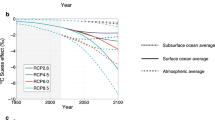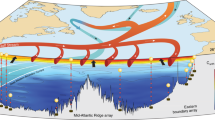Abstract
Uptake of atmospheric carbon dioxide in the subpolar North Atlantic Ocean declined rapidly between 1990 and 2006. This reduction in carbon dioxide uptake was related to warming at the sea surface, which—according to model simulations—coincided with a reduction in the Atlantic meridional overturning circulation. The extent to which the slowdown of this circulation system—which transports warm surface waters to the northern high latitudes, and cool deep waters south—contributed to the reduction in carbon uptake has remained uncertain. Here, we use data on the oceanic transport of volume, heat and carbon dioxide to track carbon dioxide uptake in the subtropical and subpolar regions of the North Atlantic Ocean over the past two decades. We separate anthropogenic carbon from natural carbon by assuming that the latter corresponds to a pre-industrial atmosphere, whereas the remaining is anthropogenic. We find that the uptake of anthropogenic carbon dioxide—released by human activities—occurred almost exclusively in the subtropical gyre. In contrast, natural carbon dioxide uptake—which results from natural Earth system processes—dominated in the subpolar gyre. We attribute the weakening of contemporary carbon dioxide uptake in the subpolar North Atlantic to a reduction in the natural component. We show that the slowdown of the meridional overturning circulation was largely responsible for the reduction in carbon uptake, through a reduction of oceanic heat loss to the atmosphere, and for the concomitant decline in anthropogenic CO2 storage in subpolar waters.
This is a preview of subscription content, access via your institution
Access options
Subscribe to this journal
Receive 12 print issues and online access
$259.00 per year
only $21.58 per issue
Buy this article
- Purchase on Springer Link
- Instant access to full article PDF
Prices may be subject to local taxes which are calculated during checkout




Similar content being viewed by others
References
Takahashi, T. et al. Climatological mean and decadal change in surface ocean pCO2, and net sea-air CO2 flux over the global oceans. Deep-Sea Res. II 56, 554–577 (2009).
Sabine, C. L. et al. The oceanic sink for anthropogenic CO2 . Science 305, 367–371 (2004).
Gruber, N. et al. Oceanic sources, sinks, and transport of atmospheric CO2 . Glob. Biogeochem. Cycles 23, GB1005 (2009).
Rosón, G., Rios, A. F., Pérez, F. F., Lavin, A. & Bryden, H. L. Carbon distribution, fluxes, and budgets in the subtropical North Atlantic Ocean (24.5°N). J. Geophys. Res. 108, 3144 (2003).
Keeling, R. F. & Peng, T-H. Transport of heat, CO2 and O2 by the Atlantic’s thermohaline circulation. Phil. Trans. R. Soc. Lond. B 348, 133–142 (1995); 348, 133–142 (1995).
Mikaloff-Fletcher, S. E. et al. Inverse estimates of the oceanic sources and sinks of natural CO2 and the implied oceanic carbon transport. Glob. Biogeochem. Cycles 21, GB1010 (2007).
Macdonald, A. M., Baringer, M. O., Wanninkhof, R., Lee, K. & Wallace, D. W. R. A 1998–1992 comparison of inorganic carbon and its transport across 24.5° N in the Atlantic. Deep-Sea Res. II 50, 3041–3064 (2003).
Álvarez, M., Rı´os, A. F., Pérez, F. F., Bryden, H. L. & Rosón, G. Transports and budgets of total inorganic carbon in the subpolar and temperate North Atlantic. Glob. Biogeochem. Cycles 17, 1002 (2003).
Quay, P. et al. Anthropogenic CO2 accumulation rates in the North Atlantic Ocean from changes in the 13C/12C of dissolved inorganic carbon. Glob. Biogeochem. Cycles 21, GB1009 (2007).
Metzl, N. et al. Recent acceleration of the sea surface fCO2 growth rate in the North Atlantic subpolar gyre (1993–2008) revealed by winter observations. Glob. Biogeochem. Cycles 24, GB4004 (2010).
Watson, A. J. et al. Tracking the Variable North Atlantic Sink for Atmospheric CO2 . Science 326, 1391–1393 (2009).
Patra, P. K. et al. Interannual and decadal changes in the sea-air CO2 flux from atmospheric CO2 inverse modeling. Glob. Biogeochem. Cycles 19, GB4013 (2005).
Thomas, H. et al. Changes in the North Atlantic Oscillation influence CO2 uptake in the North Atlantic over the past 2 decades. Glob. Biogeochem. Cycles 22, GB4027 (2008).
Gruber, N., Keeling, C. D. & Bates, N. R. Interannual variability in the North Atlantic ocean carbon sink. Science 298, 2374–2378 (2002).
Bates, N. R. Interannual variability of the oceanic CO2 sink in the subtropical gyre of the North Atlantic Ocean over the last 2 decades. J. Geophys. Res. 112, C09013 (2007).
Ullman, D. J., McKinley, G. A., Bennington, V. & Dutkiewicz, S. Trends in the North Atlantic carbon sink: 1992–2006. Glob. Biogeochem. Cycles 23, GB4011 (2009).
Kanzow, T. et al. Seasonal variability of the Atlantic meridional overturning circulation at 26.5° N. J. Clim. 23, 5678–5698 (2010).
Bryden, H. L., Longworth, H. R. & Cunningham, S. A. Slowing of the Atlantic meridional overturning circulation at 25° N. Nature 438, 655–657 (2005).
Yashayaev, I. & Dickson, B. in Arctic-Subarctic Ocean Fluxes Defining the Role of the Northern Seas in Climate (eds Dickson, R. R., Meincke, J. & Rhines, P.) 505–526 (Springer, 2008).
Lherminier, P. et al. Transports across the 2002 Greenland–Portugal OVIDE section and comparison with 1997. J. Geophys. Res. 112, C07003 (2007).
Lherminier, P. et al. The Atlantic meridional overturning circulation and the subpolar gyre observed at the A25-OVIDE section in June 2002 and 2004. Deep-Sea Res. I 57, 1374–1391 (2010).
Treguier, A. M. et al. The North Atlantic subpolar gyre in four high-resolution models. J. Phys. Oceanogr. 35, 757–774 (2005).
Gourcuff, C., Lherminier, P., Mercier, H. & Le Traon, P. Y. Altimetry combined with hydrography for ocean transport estimation. J. Atmos. Ocean. Technol. 29, 1324–1336 (2011).
Böning, C. W., Scheinert, M., Dengg, J., Biastoch, A. & Funk, A. Decadal variability of subpolar gyre transport and its reverberation in the North Atlantic overturning. Geophys. Res. Lett. 33, L21S01 (2006).
Mikaloff-Fletcher, S. E. M. et al. Inverse estimates of anthropogenic CO2 uptake, transport, and storage by the ocean. Glob. Biogeochem. Cycles 20, GB2002 (2006).
Tjiputra, J. F., Assmann, K. & Heinze, C. Anthropogenic carbon dynamics in the changing ocean. Ocean Sci. 6, 605–614 (2010).
Pérez, F. F. et al. Trends of anthropogenic CO2 storage in North Atlantic water masses. Biogeosciences 7, 1789–1807 (2010).
Hansen, B. & Østerhus, S. North Atlantic–Nordic Seas exchanges. Prog. Oceanogr. 45, 109–208 (2000).
Tanhua, T., Olsson, K. A. & Jeansson, E. in Arctic-Subarctic Ocean Fluxes Defining the Role of the Northern Seas in Climate (eds Dickson, R. R., Meincke, J. & Rhines, P.) 475–503 (Springer, 2008).
Jutterström, S. et al. Evaluation of anthropogenic carbon in the Nordic Seas using observed relationships of N, P and C versus CFCs. Prog. Oceanogr. 78, 78–84 (2008).
Anderson, L. G., Olsson, K. & Chierici, M. A carbon budget for the Arctic Ocean. Glob. Biogeochem. Cycles 12, 455–465 (1998).
Olsen, A. et al. Magnitude and origin of the anthropogenic CO2 increase and the 13C Suess effect in the Nordic Seas since 1981. Glob. Biogeochem. Cycles 20, GB3027 (2006).
Körtzinger, A., Quay, P. D. & Sonnerup, R. E. Relationship between anthropogenic CO2 and the 13C Suess effect in the North Atlantic Ocean. Glob. Biogeochem. Cycles 17, 1005 (2003).
Kieke, D. et al. Changes in the pool of Labrador Sea Water in the subpolar North Atlantic. Geophys. Res. Lett. 34, L06605 (2007).
Våge, K., Pickart, R. S., Moore, G. W. K. & Ribergaard, M. H. Winter mixed layer development in the central Irminger sea: The effect of strong, intermittent wind events. J. Phys. Oceanogr. 38, 541–565 (2008).
Steinfeldt, R., Rhein, M., Bullister, J. L. & Tanhua, T. Inventory changes in anthropogenic carbon from 1997–2003 in the Atlantic Ocean between 20° S and 65° N. Glob. Biogeochem. Cycles 23, GB3010 (2009).
Corbière, A., Metzl, N., Reverdin, G., Brunet, C. & Takahashi, T. Interannual and decadal variability of the oceanic carbon sink in the North Atlantic subpolar gyre. Tellus B 59, 168–178 (2007).
Schuster, U. & Watson, A. J. A variable and decreasing sink for atmospheric CO2 in the North Atlantic. J. Geophys. Res. 112, C11006 (2007).
Visbeck, M. et al. The ocean’s response to North Atlantic Oscillation variability. Geophys. Monogr. Ser. 134, 113–145 (2003).
Schmitz, W. J. & Richardson, P. L. On the sources of the Florida Current. Deep-Sea Res. 38, S389–S409 (1991).
Pérez, F. F. et al. Temporal variability of the anthropogenic CO2 storage in the Irminger Sea. Biogeosciences 5, 1669–1679 (2008).
Vázquez-Rodrı´guez, M. et al. Anthropogenic carbon distributions in the Atlantic Ocean: data-based estimates from the Arctic to the Antarctic. Biogeosciences 6, 439–451 (2009).
Velo, A. et al. A multiparametric method of interpolation using WOA05 applied to anthropogenic CO2 in the Atlantic. Sci. Mar. 74, 21–32 (2010).
Touratier, F., Azouzi, L. & Goyet, C. CFC-11, Δ14C and 3H tracers as a means to assess anthropogenic CO2 concentrations in the ocean. Tellus B 59, 318–325 (2007).
Waugh, D. W., Hall, T. M., McNeil, B. I., Key, R. & Matear, R. J. Anthropogenic CO2 in the oceans estimated using transit time distributions. Tellus B 58, 376–389 (2006).
Tanhua, T. et al. Ventilation of the Arctic Ocean: Mean ages and inventories of anthropogenic CO2 and CFC-11. J. Phys. Oceanogr. 114, C01002 (2009).
Daniault, N., Lherminier, P. & Mercier, H. Circulation and transport at the southeast tip of Greenland. J. Phys. Oceanogr. 41, 437–457 (2011).
Jeansson, E. et al. The Nordic Seas carbon budget: Sources, sinks, and uncertainties. Glob. Biogeochem. Cycles 25, GB4010 (2011).
Skjelvan, I. et al. in The Nordic Seas: An Integrated Perspective Oceanography, Climatology, Biogeochemistry, and Modeling (eds Drange, H. et al.) 157–175 (Geophys. Monogr. Ser., Vol. 158, AGU, 2005).
Acknowledgements
This work was supported by the Spanish Ministry of Sciences and Innovation and co-funded by the Fondo Europeo de Desarrollo Regional 2007–2012 (FEDER) through the CATARINA project (CTM2010-17141) and through EU FP7 project CARBOCHANGE ‘Changes in carbon uptake and emissions by oceans in a changing climate’, which received funding from the European Commission’s seventh Framework Programme EU under grant agreement no. 264879. The OVIDE research project was co-funded by the IFREMER, CNRS/INSU and LEFE. H.M. was supported by CNRS and P.L. by IFREMER. M.V-R. was funded by the CSIC I3P Predoctoral Grant program (I3P-BPD2005).
Author information
Authors and Affiliations
Contributions
All authors contributed extensively to the work presented in this paper. F.F.P., H.M. and A.F.R. designed the research. F.F.P., H.M., M.V-R., A.V., P.L. and A.F.R. analysed the physical and chemical data. H.M. and P.L. estimated the currents and thermohaline fields. F.F.P., M.V-R., A.V. and G.R. determined the anthropogenic CO2 concentrations and storage rates. H.M., F.F.P., P.L. and A.F.R. estimated the uncertainties. F.F.P., H.M., M.V-R., P.C.P. and A.F.R wrote the paper. All authors discussed the results and implications and commented on the manuscript at all stages.
Corresponding author
Ethics declarations
Competing interests
The authors declare no competing financial interests.
Supplementary information
Supplementary Information
Supplementary Information (PDF 517 kb)
Rights and permissions
About this article
Cite this article
Pérez, F., Mercier, H., Vázquez-Rodríguez, M. et al. Atlantic Ocean CO2 uptake reduced by weakening of the meridional overturning circulation. Nature Geosci 6, 146–152 (2013). https://doi.org/10.1038/ngeo1680
Received:
Accepted:
Published:
Issue Date:
DOI: https://doi.org/10.1038/ngeo1680
This article is cited by
-
Present-day North Atlantic salinity constrains future warming of the Northern Hemisphere
Nature Climate Change (2023)
-
Trends and variability in the ocean carbon sink
Nature Reviews Earth & Environment (2023)
-
Projected Atlantic overturning slow-down is to be compensated by a strengthened South Atlantic subtropical gyre
Communications Earth & Environment (2023)
-
Contrasting drivers and trends of ocean acidification in the subarctic Atlantic
Scientific Reports (2021)
-
Circulation-driven variability of Atlantic anthropogenic carbon transports and uptake
Nature Geoscience (2021)



